
Chapter 5: Setting the Initial Configuration
NOTE: The Juniper Networks database must be running before you start configuring the SRC software.
Typically, you run the database in standalone mode only in testing environments. In standalone mode, the database does not communicate with other Juniper Networks databases; there is no data distribution and no redundancy. In community mode, databases distribute data changes among specified databases. When you have two or more
■Primary
■Secondary
In the following example, a standalone database is enabled. For more information about community mode, see
To enable a Juniper Networks database to run in standalone mode:
1.From configuration mode, access the configuration statement that configures the Juniper Networks database.
user@host# edit system ldap server
2.Enable standalone mode.
[edit system ldap server] user@host# set
Configuring Hostname and Domain Parameters
To set hostname and domain parameters:
1.Enter configuration mode. root@host> edit
2.Configure the hostname.
[edit]
root@host# set system
For example:
[edit]
root@host# set system host-name my-hostname
Configuring Hostname and Domain Parameters ■ 23
